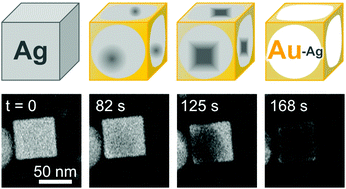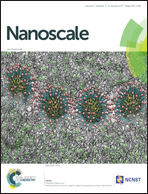In situ liquid cell electron microscopy of Ag–Au galvanic replacement reactions†
Abstract
Galvanic replacement reactions are important as they transform nanoparticle templates into complex porous and hollow metal or alloy nanostructures with interesting properties for a variety of applications. Real-time liquid cell electron microscopy (LCEM) observations of the transformation of solid nanoparticles into hollow shell and cage bimetallic nanostructures are challenging because the high-energy electron beam strongly affects the galvanic process via species such as aqueous electrons and hydroxyl radicals generated through the radiolysis of water in the liquid cell. As a result the galvanic reactions are modified by the introduction of additional pathways that can decouple the oxidation of the nanoparticles from the reduction of the metal ion complexes in solution. Here we demonstrate that changing the pH of the solution provides an effective approach to alter the balance of radiolysis products. In situ observations of the transformation of Ag nanocubes in Au salt containing neutral and acidic aqueous solutions demonstrate that a lowering of the pH by addition of H2SO4 significantly lessens radical-induced modifications of redox reactions by avoiding the excessive reduction of metal–chloro complexes by aqueous electrons (eaq−) and making the process sufficiently slow to be observed. As a result, the different stages of galvanic replacement reactions on nanoparticles can be imaged in real-time by LCEM.


 Please wait while we load your content...
Please wait while we load your content...